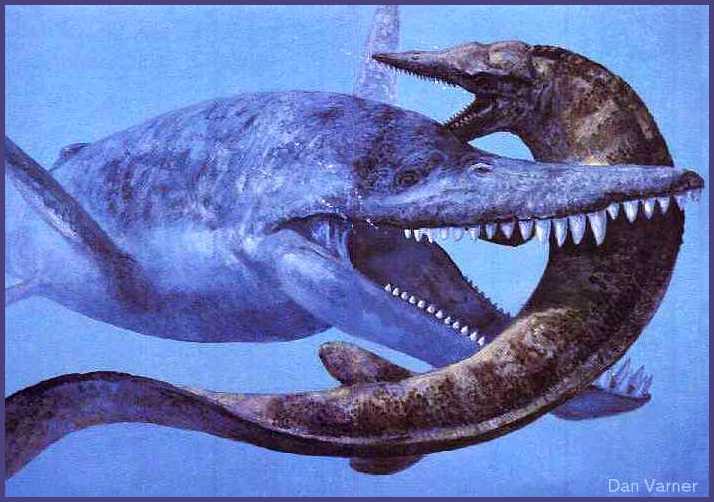 |
The Last North American
Pliosaur:
Megacephalosaurus eulerti
Remains from the Blue Hill Shale
(Middle Turonian) of
Kansas
Copyright
© 2012-2013 by Mike Everhart
Page
created 01/02/2012 Last updated 05/07/2013
LEFT:
Encounter over Kansas - One of the last pliosaurs (Megacephalosaurus
eulerti) takes out an early mosasaur. Painting by Dan Varner -
Copyright ©
Dan Varner. |
On April 3, 2010, Bruce Schumacher and I had the opportunity to search
(and literally walk right to) the long lost site of a Kansas pliosaur specimen
that was discovered in the early 1990s. The specimen was first mentioned in
Schwimmer et al. 1997. Although the landowner had intended for
the specimen (FHSM VP-17469) to be donated to the Sternberg Museum of Natural History, it ended
up, un-curated, in a Los Angeles museum, and has since been
"misplaced." We are currently seeking it's return.
The specimen was originally discovered in a large septarian concretion by
amateur rock collectors. Judging from the abundance of large bone fragments that
we found in the debris yesterday, the concretion was broken apart haphazardly in
an attempt to recover the remains, which reportedly included a partial skull,
limb bones and ribs.
Although we able to salvage some meaningful fragments, including large (5 in /13
cm) teeth and jaw fragments, we will have to return to the site at a later date
and do an additional excavation. The site is fairly unique in that the only
exposed rocks are a very few septarian concretions. Everything else is rolling
hills and grassland. Fortunately, the concretions stand out in the grass because
of their yellow-orange color. The first concretion that Bruce flipped over
contained most of a Collignoniceras hyatti ammonite (below).
This is the first known pliosaur from Blue Hills Shale Member of the Carlile
Shale (late middle Turonian) and thus it is the youngest pliosaur specimen known
from North America....(never mind that represents the largest vertebrate
specimen EVER collected from the Blue Hill Shale). Our previous upper
record (Brachauchenius lucasi - FHSM VP-321) was collected from the lower
(older) Fairport Chalk Member.
Note that I did report (2009) on a probable rib of a large plesiosaur (FHSM
VP-17299) from the Blue Hill Shale, and have since found fragments of a
plesiosaur propodial (FHSM VP-17596) at a nearby locality.
Below are some pictures from our Saturday adventure..... A rolling grassland
is a bit of an unusual place to find a big pliosaur... We have since learned that the big propodial was laying on the surface when the site was initially discovered.... otherwise, there is nothing but grass and a few concretions.
When we started out from the van, we only knew that the site was located on the side of a hill in the southeast quarter section.... we walked to the highest spot we could find and looked around... nothing there, so we decided to go further east to the next largest hill... as we went up a small rise,
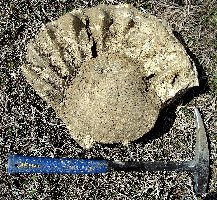 |
LEFT: Bruce spotted a small concretion ... flipped it over and found a nearly complete ammonite...
Collignoniceras hyatti ... a good omen to start the day. (Rock
hammer is 16 inches - 41 cm in length)
RIGHT: Leaving the ammonite for later pick up, we headed up the next rise and immediate saw fragments of a large septarian concretion... The first large fragment we looked at had lots of bone in it...
Here Bruce is surveying the busted concretion that we saw as we walked up the hill. The hill in the background is capped by the Fort Hays Limestone. |
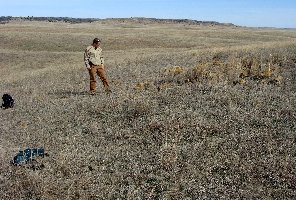 |
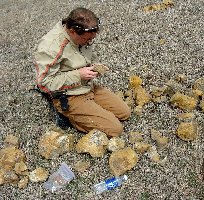 |
LEFT: We sorted through the broken septarian concretion and picked out those chunks that contained bone
fragments. According to our records, the skull was contained in the large concretion... and most of the fragments of large bones are probably from the skull... Not as big as Predator X.. but certainly a large pliosaur.
RIGHT: One of the larger pieces of the concretion with showing bone
fragments. (Rock hammer is 16 inches - 41 cm in length)
|
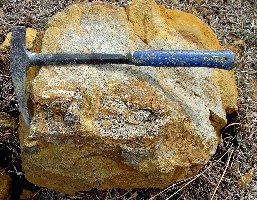 |
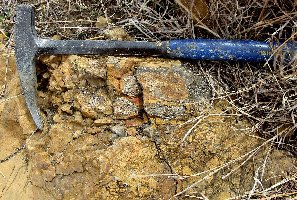 |
LEFT: One of the larger pieces of the concretion still in
the soil, showing bone fragments. (Rock hammer is 16 inches - 41 cm in
length)
RIGHT: Another piece of the concretion. This original was a huge
skull, probably close to 2 m in length, from an animal that would have
been 5 to 6 m overall.
|
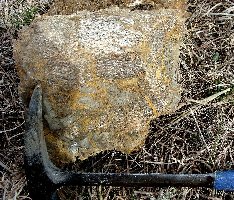 |
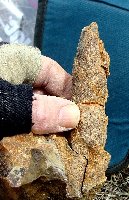 |
LEFT: One of the best finds of the day was a nearly complete tooth, or at least the core of a tooth... being enclosed in a septarian concretion does strange things to vertebrate bones and teeth... none of them good. This is a field photo of the tooth.
RIGHT: We recovered a number of bone fragments that were most likely cross sections of the dentarys or maxillae.... hard to tell at this point... but they definitely revealed some teeth in cross section.. judging from the surrounding bone, these may have been pre-emergent,
replacement teeth. I suspect both of the teeth shown below are from the
maxillae. (Scale = cm). |
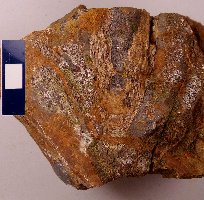 |
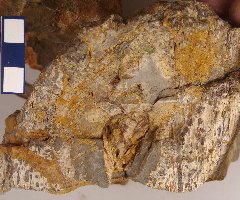 |
LEFT: Although most of the teeth were in pretty bad shape, we did find enamel preserved on some of them, complete with nice striations.... more to come on that
subject. (Scale = cm).
RIGHT: A close up view of some of the remaining enamel. (Scale
= mm).
|
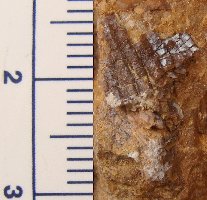 |
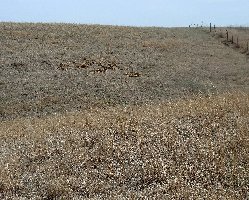 |
LEFT: After exploring the site as much as possible given that the soil was very wet, we did a 'walk-about' to see what else we could find.... Aside from a very few concretions containing shattered ammonites, there wasn't much else visible on the prairie.... so we loaded up and carried a few selected fragments (and the ammonite) over two hills and up to the van. This is a distant view of the site, looking to the east.... The fence posts are along an abandoned road that would have made this dig much easier....
RIGHT: A week later, Bruce collected a series of fairly large
mosasaur caudal vertebrae in the Fairport Chalk (lower Middle
Turonian)..... so it appears that the two groups over lapped by at least a
million years (see Schumacher 2011). There are several other
fragmentary mosasaur specimens from the Fairport Chalk...I have no doubt
that a pliosaur would have preyed on mosasaurs, given the opportunity. |
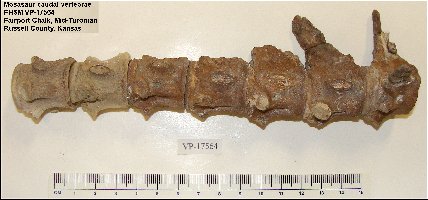 |
It's now been over a year since we visited the site... Hopefully we'll
find the time in 2012.
Suggested references:
Bell
, G.L., Jr. and Polcyn, M.J. 2005. Dallasaurus
turneri, a new primitive mosasauroid from the Middle Turonian of
Texas
and comments on the phylogeny of Mosasauridae (Squamata). pp.
177-194 in Schulp, A.S. and Jagt, J.W.M. (eds): Proceedings of the First
Mosasaur Meeting. Netherlands
Journal of Geosciences 84(3).
Bell, G.L., Jr. and VonLoh, J.P. 1998. New
Records of Turonian mosasauroids from the western
United States. South Dakota
School
of Mines, Dakoterra 5:15-28.
Everhart, M.J. 2002.
New data on cranial measurements and body length of the mosasaur, Tylosaurus
nepaeolicus (Squamata: Mosasauridae), from the Niobrara Formation of western
Kansas
.
Kansas
Academy
of Science, Transactions 105(1-2):33-43.
Everhart, M.J. 2005. Earliest record of the genus Tylosaurus
(Squamata; Mosasauridae) from the
Fort
Hays
Limestone (Lower Coniacian) of western
Kansas
.
Kansas
Academy
of Science, Transactions 108(3-4):149-155.
Everhart, M.J. 2005. Oceans of Kansas
- A Natural History of the Western Interior Sea. Indiana University Press,
322 pp.
Everhart, M.J. 2005. Tylosaurus
kansasensis, a new species of tylosaurine (Squamata: Mosasauridae) from the
Niobrara Chalk of western
Kansas
,
U.S.A.
pp. 231-240 in Schulp, A.S. and Jagt, J.W.M. (eds): Proceedings of the First
Mosasaur Meeting.
Netherlands
Journal of Geosciences 84(3).
Everhart, M.J. 2009. Probable plesiosaur remains from
the Blue Hill Shale (Carlile Formation; Middle Turonian) of north central
Kansas
.
Kansas
Academy
of Science, Transactions 112(3/4):215-221.
Hattin, D.E. 1962. Stratigraphy of the
Carlile Shale (Upper Cretaceous) in
Kansas
. State Geological Survey of
Kansas
, Bulletin 156, (
University
of
Kansas
pub.) 155 pp., 2 pl.
Kauffman, E.G., Sageman, B.B.,
Kirkland
, J.I., Elder, W.P., Harries, P.J. and Villamil, T. 1993. Molluscan
biostratigraphy of the
Cretaceous
Western
Interior
Basin
,
North America
. pp. 397-434 in
Caldwell
, W.G.E. and Kauffman, E.G. (eds.): Evolution of the
Western
Interior
Basin
, Geological Association of
Canada
, Special Paper 39.
Liggett, G.A., Shimada, K.,
Bennett
,
S.C.
and Schumacher, B.A. 2005. Cenomanian (Late Cretaceous) reptiles from
northwestern
Russell
County
,
Kansas
. PaleoBios 25(2):9-17.
Lindgren,
J.,
Caldwell
, M.W., Konishi, T. and Chiappe, L.M. 2010. Convergent evolution in aquatic
tetrapods: insights from an exceptional fossil mosasaur. PLoS ONE 5(8):1-10.
Logan
, W.N. 1897. The Upper Cretaceous of
Kansas
, with an introduction by Erasmus Haworth.
Kansas
University
Geology Survey Bulletin 2:195-234.
Martin,
L.D. and Stewart, J.D. 1977. The oldest (Turonian) mosasaurs from
Kansas
, Journal of Paleontology 51(5):973-975.
Polcyn, M.J. and
Bell
, G.L. Jr. 2005. Russellosaurus coheni n. gen.
n. sp., a 92 million-year-old mosasaur from
Texas
(
USA
), and the definition of the parafamily Russellosaurina. pp. 321-323 in Schulp,
A.S. and Jagt, J.W.M. (eds): Proceedings of the First Mosasaur Meeting.
Netherlands
Journal of Geosciences 84(3) .
Polcyn, M.J.,
Bell
, G.L., Jr., Shimada, K. and Everhart, M.J. 2008. The oldest North American
mosasaurs (Squamata: Mosasauridae) from the Turonian (Upper Cretaceous) of
Kansas
and
Texas
with comments on the radiation of major mosasaur clades. Proceedings of the
Second Mosasaur Meeting,
Fort
Hays
State
University
, Hays,
Kansas
,
Fort
Hays
Studies Special Issue 3:137-155.
Russell, D.A. 1967. Systematics and morphology of
American mosasaurs.
Bulletin
Peabody
Museum
of Natural History 23:1-241,
Yale
University
,
New Haven
,
Connecticut
.
Schumacher,
B.A. 2002. A new specimen of Trinacromerum bentonianum from the Carlile Shale (Turonian) of
Kansas
. Abstracts of the Annual Meeting,
Kansas
Academy
of Science 21:31.
Schumacher, B.A. 2005. Unique paddle configuration of
the pliosaur (Plesiosauria) Brachauchenius
lucasi. Journal
of Vertebrate Paleontology 25 (Supplement to 3):111A.
Schumacher,
B.A. 2007. A new polycotylid
plesiosaur (Reptilia; Sauropterygia) from the Greenhorn Limestone (Upper
Cretaceous; lower upper Cenomanian), Black Hills,
South Dakota
. pp. 133-146 in Martin, J.E., and
Parris
,
D.C.
(eds.), The Geology and Paleontology of the Late Cretaceous Marine Deposits of
the Dakotas: Geological Society of
America
Special Paper 427: 133-146.
Schumacher, B.A. 2008. On a pliosaur skull
(Plesiosauria) from the Upper Cretaceous (early Turonian) of the North American
Western Interior.
Kansas
Academy
of Science, Transactions 111(3/4):203-218. (Errata figure in 112(3/4):234).
Schumacher, B.A. 2011. A ‘woollgari-zone mosasaur’ (Squamata;
Mosasauridae) from the Carlile Shale (Lower Middle Turonian) of central Kansas
and the stratigraphic overlap of early mosasaurs and pliosaurid plesiosaurs.
Kansas Academy of Science, Transactions 114(1-2):1-14.
Schumacher, B.A., Carpenter, K., and Everhart, M.J.
2012. A new pliosaur (Plesiosauria, Pliosauridae) from the Carlile Shale
(Cretaceous, Middle Turonian) of Russell County, Kansas. Supplement to the
online Journal of Vertebrate Paleontology ISSN 1937-2809, pp.
168-169.
Schumacher, B.A.,
Carpenter, K. and Everhart, M.J. 2013. A new Cretaceous Pliosaurid (Reptilia,
Plesiosauria) from the Carlile Shale (middle Turonian) of Russell County,
Kansas, Journal of Vertebrate Paleontology 33(3):613-628
Schumacher,
B.A. and Everhart, M.J. 2005. A stratigraphic and taxonomic review of
plesiosaurs from the old “Fort Benton Group” of central
Kansas
: a new assessment of old records. Paludicola 5(2):33-54.
Schumacher,
B.A. and Varner, D.W. 1996. Mosasaur caudal anatomy. Journal of Vertebrate
Paleontology 16(Supplement to 3):63A.
Schumacher,
B.A. and Varner, D.W. 2007. Morphology and function of tailbends in
mosasaurs. 2nd International Mosasaur Meeting,
Fort Hays State University
,
Kansas
, Abstract Booklet, p. 24.
Schwimmer, D.R., Stewart, J.D. and Williams, G.D.
1997. Scavenging by sharks of the genus Squalicorax
in the Late Cretaceous of
North America
. Palaios 12:71-83.
Shimada, K., Everhart, M. Reilly, B. and Rigsby, C.
2011. First associated specimen of the Late Cretaceous shark, Cretodus
(Elasmobranchii: Lamniformes). Journal of Vertebrate Paleontology 31 (Supplement
to 3):194.
Shimada, K., Schumacher, B.A., Parkin, J.A. and Palermo, J.M. 2006. Fossil marine vertebrates from the lowermost Greenhorn Limestone
(Upper Cretaceous: Middle Cenomanian) in southeastern Colorado. Journal of Paleontology 80 (Supplement to 2), Memoir 63:45pp.
Stewart, J.D. and
Bell, G.L., Jr. 1994.
North America
’s oldest mosasaurs are teleosts.
Natural
History
Museum
of
Los Angeles
County, Contributions in Science, Number 441:1-9.
Storrs, G.W. 1981. A review of occurrences of the plesiosauria (Reptilia:
Sauropterygia) in
Texas
with description of new material. Unpublished Masters Thesis, The
University
of
Texas
at
Austin
, 226 pp.
VonLoh, J.P. and Bell,
G.L., Jr. 1998. Fossil reptiles from the Late Cretaceous Greenhorn Formation
(Late Cenomanian - Middle Turonian) of the Black Hills region, South Dakota. South Dakota
School
of Mines, Dakoterra 5:29-38.
Williston, S.W. 1914. Water
Reptiles of the Past and Present.
Chicago
University
Press, 251 pp.












